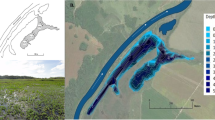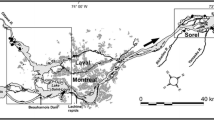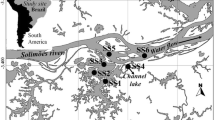Abstract
To study effects of altitude, monthly sampling was undertaken from June 1993 to May 1996 in the upper Kodayar reservoir (1312 m ASL), the lower Kodayar (92 m ASL) and Azhakia Pandiapuram (plain) (Tamilnadu, India). Temperature decreased with elevation at a rate of 1 °C per 240 m; the thermal range also decreased with increasing altitude. The number of days and quantity of precipitation decreased from 161 days and 366 cm yr-1 in the upper Kodayar to 92 days and 127 cm yr-1 at the Azhakia Pandiapuram (APP). Transparency decreased from 1.5 m at the upper Kodayar to about 0.5 m at the APP. Dissolved oxygen increased with decreasing altitude but remained high (>7 mg l-1) in all the three systems. Throughout the investigation, the upper Kodayar reservoir (<6.8) and lower Kodayar lake (<7.0) remained acidic, while the APP was always alkaline. Trends for CO2 and alkalinity of the three Kodayar systems were parallel to those for pH. Though widely oscillating across calendar months, nitrate averaged c. 30 μg l-1, while phosphate increased from 8 μg l-1 in the upper Kodayar to 18 μg l-1 at the APP. Wide oscillations in nitrate suggest that it may be limiting productivity more than phosphorus. Chlorophyll-a values were c. 1.9 μg l-1 throughout the year in the upper Kodayar, and between 10 and 20 μg l-1 in the other two ecosystems; values peaked during the dry season, from January to April. Chlorophyll-a concentrations correlated positively with productivity; every μg increase in chlorophyll-a caused 0.15 gC m-3 d-1 more production. The pristine water of the fragile upper Kodayar had the lowest productivity, and poorest diversity and population density. The species richness was assessed using organisms larger than 75 μm filtered by a plankton net. There were five species (Staurastrum spp., Staurodesmus spp., Botryococcus) of phytoplankton, and three species of cladocerans and five species of copepods; population density averaged to 159 l-1 for phytoplankton, 0.3 l-1 for zooplankton. The lower Kodayar proved to be the richest for species diversity; there were 14 species of phytoplankton and six species of cladocerans and six species of copepods. Population density averaged to 203 l-1 for phytoplankton and 0.44 l-1 for zooplankton. The APP displayed moderate species richness; there were seven species of phytoplankton and six species of cladocerans, eight species of copepods and three species of rotifer; but the population density was comparatively higher than the upper and lower Kodayar; it averaged 412 l-1 for phytoplankton and 5.9 l-1 for zooplankton. These values fell within the range of values reported for other tropical and temperate lakes. Staurastrum, Ceriodaphnia cornuta, Tropocyclops, Thermocyclops and Mesocyclops sp. were present in all the aquatic systems and tolerated wide range pH between 6.5 and 8.0. APP was the most productive (4.4 gC m-3 d-1). Productivity holds positive correlation with pH and temperature; for every 1 °C increase in temperature it increased by 0.39 gC m-3 d-1 in these aquatic systems.
Similar content being viewed by others
References
Abbasi, S. A., N. Abbasi & K. K. S. Bhatia, 1996. Wetlands of India: ecology and threats. Vol. 3. The Wetlands of Kerala, Discovery Publishing House, New Delhi: 33–64.
APHA, 1985. Standard methods for the examination of water and waste water. 16th edn. American Publication Health Assoc. Inc. Washington D.C. 1268 pp.
APHA, 1992. Standard methods for the examination of water and waste water. 18th edn. American Publication Health Assoc. Inc. Washington D.C. 1002 pp.
Beaver, J. R. & T. I. Crisman, 1991. Temporal variability in algal biomass and primary productivity in Florida lakes relative to latitudinal gradients, organic colour and trophic state. Hydrobiologia 224: 89–97.
Bhatnagar, G. P., 1984. Limnological study on lower lake, Bhopal Research Project. Man and Biosphere Programme, Unesco, Department of Environment, Govt. of India, New Delhi: 73 pp.
Devaraj, K. V., H. S. Mahadeva & A. A. Fazal, 1988. Hydrobiology of Hemavathi Reservoir. Proc. of Asian Fish. Soc., Mangalore: 323–327.
Dumont, H. J. & Y. R. Reddy, 1993. A reappraisal of the genus Phyllodiaptomus Kiefer, 1936, with the description of P. wellekensae n.sp. from India, and a redescription of P. tunguidus Shen & Tai, 1964 from China (Copepoda, Calanoidea). Hydrobiologia 263: 65–93
Ganapathi, S. V. & Chacko, 1951. A hydrobiological survey of the waters of upper Palnis with a view of fish culture. Arch. Hydrobiol. 45: 543–556.
Gasse, G., J. F. Talling & P. Kilham, 1983. Diatom assemblages in East Africa: Classification, distribution and ecology. Rev. Hydrobiol. Trop. 16: 3–34.
Green, J., S. A. Corbet, E. Watts & O. B. Lan, 1996. Comparative studies on Indonesian lakes. In Schiemer, F. & K. T. Boland (eds), Perspective in Tropical Limnology. Academic Publishing, Amsterdam: 101–111.
Haniffa, M. A. & T. J. Pandian, 1978. Morphometry, primary productivity and energy flow in a tropical pond. Hydrobiologia 59: 23–48.
Harikrishnan, K. & P. K. A. Azis, 1989. Ecology of the Neyyar reservoir a preliminary report. Proceedings of Kerala Science Congress, Cochin 140-145 pp.
Hart, R. C., 1996. Comparative ecology of plankton in cascading warm-water reservoirs: aspects of relevance to tropical limnology. In Schiemer, F. & K. T. Boland (eds), Perspective in Tropical Limnology. Academic Publishing, Amsterdam: 113–130.
Hutchinson, G. E., 1967. A treatise on Limnology. II. Introduction to Lake Biology and the Limnoplankton. John Wiley & Sons. New York: 1115 pp.
Jana, B. B. & G. Kundu, 1993. Influence of prolonged summer on the limnology and chlorophyll-a content of phytoplankton in two tropical fish ponds. Arch. Hydrobiol. Suppl. 90: 507–532.
Jayachandran, K. V. & N. I. Joseph, 1988. Meterological and hydrographical features of Vellayani lake, Kerala, India. Int. Rev. ges. Hydrobiol. 73: 113–121.
Job, S. V. & V. Kannan, 1980. The detritus limnology of Sathiar reservoir. Hydrobiologia 72: 81–84.
Jones, J. R. & R. W. Bachmann, 1976. Prediction of phosphorus and chlorophyll levels in lakes. J. Wat. Pollut. Cont. Fed. 48: 2176–2182.
Kannan, V. & S. V. Job, 1980. Diurnal, seasonal, and vertical study of primary production in Sathiar reservoir. Hydrobiologia 70: 171–178.
Khatri, T. C., 1985. A note on the limnological characters of the Idukki Reservoir. Indian J. Fish. 32: 267–269.
Khatri, T. C., 1992. Hydrobiology of Idukki reservoir of Kerala, India. Oikoassay 9: 41–46.
Lewis, W. M. Jr., 1978. A compositional, phytogeographical and elementary structural analysis of the phytoplankton in a tropical lake: Lake Lanao, Philippines. J. Ecol. 66: 213–226.
Lewis, W. M. Jr., 1996. Tropical lakes: how latitude makes a difference. In Schiemer, F. & K. T. Boland (eds), A Perspective in Tropical Limnology. Academic Publishing, Amsterdam: 43–64.
Likens, G. E., 1975. Primary production of inland aquatic ecosystems. In Lieth, H. & R. H. Whittaker (eds), The Primary Productivity of the Biosphere. Springer-Verlag, New York.
Margraf, J., M. Voggesberger & P. P. Milan, 1996. Limnology of Ifugao rice terraces, Philippines. In Schiemer, F. & K. T. Boland (eds), Perspective in Tropical Limnology. Academic Publishing, Amsterdam: 305–319.
Michael, R.G & B.K. Sharma, 1988. Fauna of India and adjacent countries (Crustacea: Branchiopods: Cladocera) Zool. Sur. India, Publ. No 1. 262 pp.
Munshi, J. S. D. & D. K. Singh, 1991. Physiochemical profile of river Ganga at Kahalgaon, Bihar, India. In Gopal, B. & V. Asthana (eds), Aquatic Sciences in India. Indian Assoc. Limnol. Oceanogr: 83-92.
Murthy, K. S. N., T. S. N. Murthy & V. Seshavatharam, 1985. Studies on the effect of some heavy metals on the phytoplankton production. J. Swamy Bot. Club 2: 21–26.
Nasar, S. A. K. & J. D. Munshi, 1975. Studies of primary production in a freshwater pond. Jap. J. Ecol. 25: 21–23.
Nasar, S. A. K. & S. Kaur, 1982. Observations on the abiotic factors and planktonic periodicity in a shallow pond of the highlands of Shillong (India). Acta. Hydrochim. Hydrobiol. 10: 167–175.
Natarajan, A. V., 1983. Ecology and fisheries of fresh water reservoir Nagarjunasagar. Inland Fish. Res. Information Ser. 3: 66.
Nauwerck, A., 1994. A survey on water chemistry and plankton in high mountain lakes in northern Swedish Lapland. Hydrobiologia 274: 91–100.
Needham, J. G. & P. R. Needham, 1962. A Guide to the Study of Freshwater Biology, 5th edn. Holden-Day, Inc., San Francisco: 108 pp.
Patil, C. S. & B. Y. M. Gouder, 1989. Freshwater Invertebrates of Dharwad, Karnataka State, India. Karnatak University Press, Dharwad: 144 pp.
Pennak, R., 1957. Species composition of limnetic zooplankton communities. Limnol. Oceanogr. 2: 222–232.
Prepas, E. E. & D. O. Trew, 1983. Evaluation of the phosphorus-chlorophyll relationship for lakes off the Precambrian shield in Western Canada. Can. J. Fish. aquat. Sci. 40: 27–35.
Prescott, G.W., 1984. The Algae: A Review, B. Singh & M.P. Singh, India and Otto Koeltz, Science Publishers, W. Germany: 436 pp.
Reddy, Y. R., 1994. Copepoda: Calanoida: Diaptomidae. Key to the genera Heliodiaptomus, Allodiaptomus, Neodiaptomus, Phyllodiaptomus, Eodiaptomus, Arctodiaptomus and Sinodiaptomus. SPB Academic, The Hague: 221 pp.
Sahib, S. S. & P. K. Azis, 1989. Post impoundment water quality of the Kallada river-A preliminary report. Proc. Kerala Science Congress. Cochin: 153–160.
Sehgal, K. L., 1983. Planktonic copepods of freshwater ecosystem. Environmental Science Series, Inteprint, New Delhi: 169 pp.
Shortreed, K.S. & J.G. Stockner, 1986. Trophic satus of 19 subartic lakes in the Yukon Territory. Can J. Fish. Aquat. Sci. 43: 797–805.
Sreenivasan, A., 1964a. A hydrological study of a tropical impoundment of Bhavanisagar reservoir, Madras state, India for the years 1956-1961. Hydrobiologia 24: 514–539.
Sreenivasan, A., 1964b. Limnological studies and fish yield in three upland lakes of Madras State, India. Limnol. Ocenogr. 9: 564–574.
Sreenivasan, A., 1968. The limnology and fish production in two ponds of Chenglepet (Madras). Hydrobiologia 38: 131–144.
Sreenivasan, A., 1970. Limnology of tropical impoundments: a comparative study of the major reservoirs in Madras state (India). Hydrobiologia 36: 443–469.
Strickland, J. D. & T. R. Parsons, 1968. A practical hand book of sea water analysis, Bull. Fish. Res. Bd., Canada 167: 185–206.
Sugunan, V. V., 1997. Fisheries management of small water bodies in seven countries in Africa, Asia and Latin America. FAO Technical circular No. 933. Food and Agricultural Organization of the United Nations, Rome: 149 pp.
Sumitra, V., 1971. Seasonal variation in primary productivity in three tropical ponds. Hydrobiologia 38: 395–408.
Talling, J. F., 1992. Environmental regulation in African shallow lakes and wetlands. Rev. Hydrobiol. Trop. 25: 87–144.
Thomas, S. & P. K. Azis, 1996. Spatial and temporal distribution of nutrients in the Peppara reservoir-A man made ecosystem on the Western Ghats, South India. Poll. Res. 15: 5–10.
Trivedy, R. K. & P. K. Goel, 1986. Chemical and Biological Methods for Water Pollution Studies. Environmental Publications, Karad, India: 251 pp.
Vollenwider, R. A., 1971. A Manual on Methods for Measuring Primary Production in Aquatic Environments. IBP Handbook. Blackwell Scientific Publications, Oxford: 213 pp.
Vyhnalek, V., J. Fott & J. Kopacek, 1994. Chlorophyll-phosphorus relationship in acidified lakes of the High Tatra Mountains (Slovakia). Hydrobiologia 274: 171–177.
Ward, H. B. & G. C. Whipple, 1959. Freshwater Biology, 2nd edn. W. T. Edmondson (eds), John Wiley, New York: 1248 pp.
Welch, P. S., 1948. Limnological Methods. McGraw Hill Book Co., New York: 381 pp.
Wen, Y. H., 1992. Contribution of bacterioplankton, phytoplankton, zooplankton and detritus to organic seston carbon load in a Changjiang floodplain lake (China). Arch. Hydrobiol. 126: 213–238.
Author information
Authors and Affiliations
Rights and permissions
About this article
Cite this article
Murugavel, P., Pandian, T.J. Effect of altitude on hydrology, productivity and species richness in Kodayar – a tropical peninsular Indian aquatic system. Hydrobiologia 430, 33–57 (2000). https://doi.org/10.1023/A:1004069013459
Issue Date:
DOI: https://doi.org/10.1023/A:1004069013459




